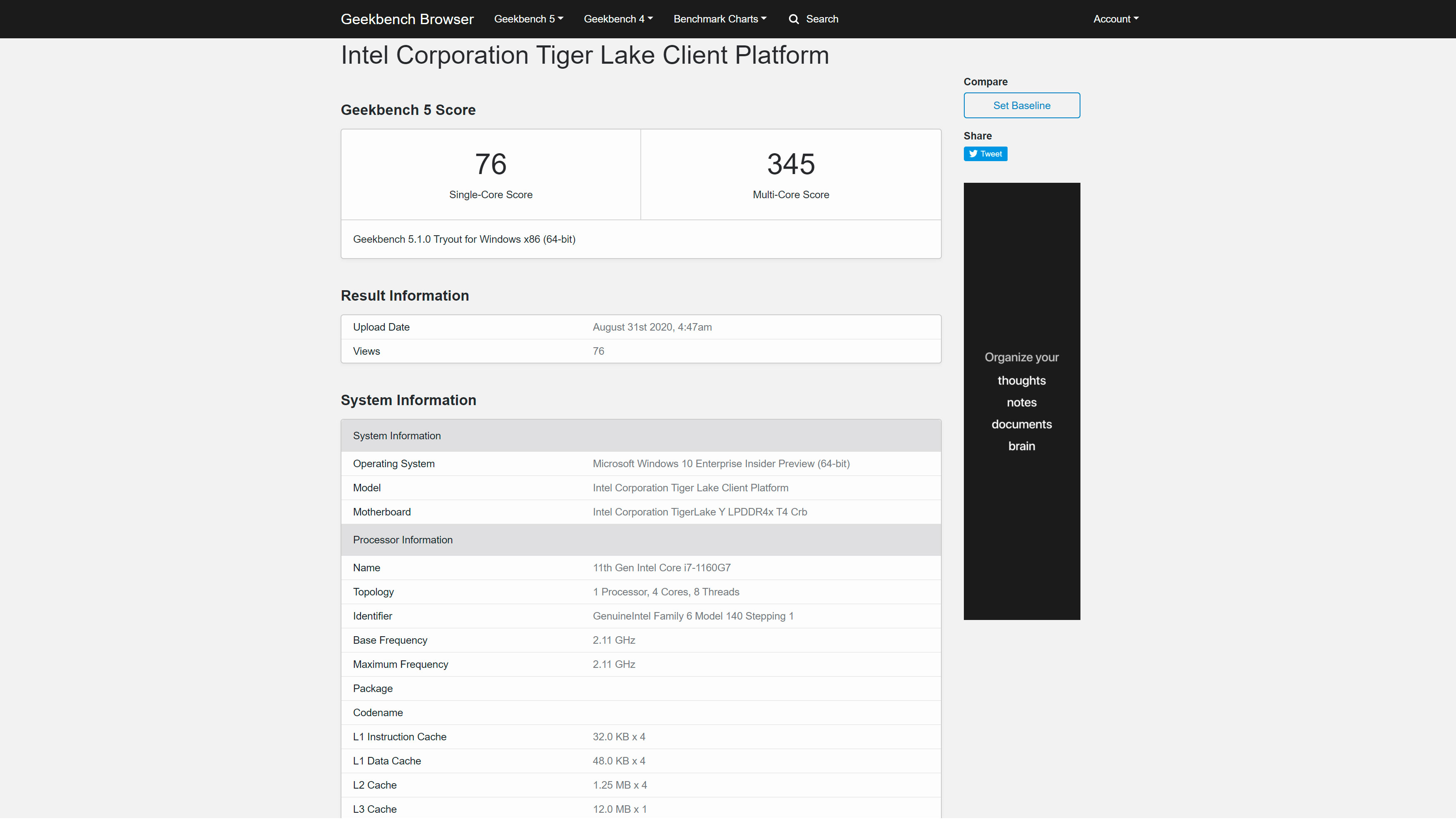New Tiger Lake Promo Vids and CPUs Leak Ahead of Official Launch
Intel is preparing the much anticipated 11th Generation Tiger Lake launch and a whole slew of new promotional videos have leaked, which we've interspersed in this article. New listings for Tiger Lake chips that will vie for a spot on our Best CPU list have also flooded the Internet.
pic.twitter.com/qP48LI9LYqAugust 28, 2020
Commencing with the juicy stuff, hardware sleuth @TUM_APISAK dug up two previously unknown Tiger Lake processors in the Geekbench 5 database. On one side, we have the Core i7-1160G7, which appears to be a quad-core chip with Hyper-Threading. The Tiger Lake-Y processor rocks a 1.2 GHz base clock and 2.11 GHz boost clock in addition to the 12MB of L3 cache. In the past, Intel's Y-series parts adhered to a 4.5W TDP (thermal design power), so unless the chipmaker has switched things up, the Core i7-1160G7 should be rated for 4.5W.
The Core i3-1115G4 also surfaced in a device called Volteer, which is the alleged codename for Chromebooks that feature Tiger Lake chips. According to Geekbench 5, the Core i3-1115G4 features two cores and lacks Hyper-Threading. The report contradicts a previous submission that painted the Core i3-1115G4 with a dual-core, four-thread configuration. Geekbench 5 reported clock speeds of 3 GHz and a 4.1 GHz for the base and boost clock, respectively. The dual-core chip has 6MB of L3 cache at is disposal. Given its specifications, the Core i3-1115G4 most likely belongs to the Tiger Lake-U family, meaning its TDP probably varies between 15W and 28W.


pic.twitter.com/X0yWZVDjaqAugust 29, 2020
Information on the Core i7-1160G7 and Core i3-1115G4's iGPU wasn't available. However, we already know that Tiger Lake is equipped with Intel's Xe LP graphics. The maximum configuration tops out at 96 Execution Units (EUs) with clock speeds up to an impressive 1.55 GHz. Considering the power restrictions on the Core i7-1160G7 and the tier of the Core i3-1115G4, the two chips will probably come with a more modest iGPU, though.
pic.twitter.com/Nr5qwpnmGjAugust 28, 2020
In other news, Twitter user WalkingCat shared multiple promotional videos of Intel's 11th Generation Tiger Lake processors. The videos show Intel's revamped logos for Tiger Lake as well as some of the devices that will be leveraging the 10nm chips. There are other interesting tidbits too, such as die shots of the Tiger Lake silicon, the initial core and thread configurations, clock speeds, and other details.
pic.twitter.com/aooLEtYRjbAugust 29, 2020
Intel will unleash Tiger Lake on September 2, so don't forget to mark your calendars. If the the processor live up to everything that we've seen so far, Tiger Lake will certainly disrupt the laptop market.
pic.twitter.com/Z5s6OWWpDlAugust 29, 2020
pic.twitter.com/Z2xKWRCfaoAugust 28, 2020
Get Tom's Hardware's best news and in-depth reviews, straight to your inbox.

Zhiye Liu is a news editor, memory reviewer, and SSD tester at Tom’s Hardware. Although he loves everything that’s hardware, he has a soft spot for CPUs, GPUs, and RAM.
-
mdd1963 4c/8t would certainly be fine for my own laptop needs (as I don't use them much any more!), but...Reply
Well, when are new desktop CPUs coming out???! Specifically, in something other than 14nm.... -
PCWarrior Reply
Next desktop gen is Rocket lake and will be on 14nm++++ too unless Intel can make another iteration of 14nm (14nm+++++). It will be the same architecture (Willow Cove) as Tigerlake but backported from 10nm to 14nm so probably there are compromises and hence not the same IPC. Rockletlake will probably be released at the end of this year or start of the next (at CES).mdd1963 said:4c/8t would certainly be fine for my own laptop needs (as I don't use them much any more!), but...
Well, when are new desktop CPUs coming out???! Specifically, in something other than 14nm....
Alder lake is the generation after that and the first to include desktop 10nm chips. It will be released in H2 2021 - I would expect a launch at the end of the year (late November) with limited availability initially and good availability from February 2022. So to answer your question I would say in 17 months you should be able to buy at a reasonable price Intel's 12-gen 10nm (super-fin enhanced) flagship K-series desktop cpu.
By the way Intel's 10nm goes now goes like this (officially)
Canon lake - 10nm- (that's minus)
Icelake - 10nm (the plus is red-conned)
Tigerlake - 10nm SF (Intel says that compared to the "+" used in 14nm, this jump over Icelake 10nm is equivalent to four "+"s)
Alderlake - 10nm ESF (that should probably be a regular iteration similar to a '+' in the 14nm)
So if Intel didn't drop the '+' notation, then Alderlake would be called 10nm+++++. And if didn't redcon Icelake 10nm+ back to 10nm, the pluses of Alderlake would have been 6!!! So that's a rather improved process from the Canonlake-era. If you think about it, it will be like going from Broadwell to Rocketlake but this time without releasing any of the Broadwell, Skylake, Kabylake, Coffeelake, Coffeelake-R, and Comet lake for the desktop. -
watzupken Looking forward to see what Tiger Lake can bring to the table in terms of performance and efficiency. Intel has hyped up this product with the, Xe graphics, SuperFin and SuperMin, so hopefully it lives up to the hype.Reply